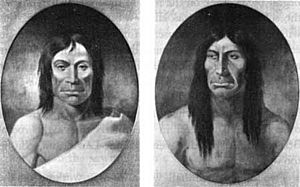Tiloukaikt facts for kids
Tiloukaikt (also known as Tilokaikt or Teelonkike) was an important leader of the Cayuse people in the northwestern United States. He lived in the 1800s. Tiloukaikt played a key role in the events known as the Whitman incident and the Cayuse War that followed.
Contents
Who Was Tiloukaikt?
Tiloukaikt was a respected leader of the Cayuse tribe. The Cayuse are a Native American group. They lived in what is now the state of Oregon. Tiloukaikt was known for his strength and leadership.
Living in the Walla Walla Valley
The Cayuse people lived in the Walla Walla Valley. This area was their main homeland. Their neighbors, the Nez Perce, also lived nearby. The valley was a rich and important place for both tribes.
The Whitman Mission Arrives
In 1835, a Presbyterian missionary named Marcus Whitman came to the valley. Tiloukaikt and other Cayuse leaders agreed to let him build a mission. Later, Marcus Whitman and his wife, Narcissa, built the mission. It was called Waiilatpu.
The mission also had a school. Narcissa Whitman taught many Cayuse children there. The mission was also a stop for travelers. These travelers were using the Oregon Trail.
Growing Tensions and Sickness
At first, the Cayuse and Nez Perce got along well with the missionaries. But over time, problems started to grow. There were misunderstandings between different groups. Also, more and more white settlers came to the area.
These new settlers brought diseases with them. Diseases like measles and scarlet fever spread. Both white people and Native Americans got sick. Marcus Whitman was a doctor. He tried to help everyone. But Native Americans had no protection against these new diseases. More Cayuse people died than white settlers.
As more Cayuse children died, some people grew suspicious. They worried that Whitman was poisoning them. Some white settlers even encouraged this belief.
The Attack at Waiilatpu
In 1847, a measles outbreak made things worse. On November 29, Tiloukaikt visited the mission. He wanted medicine and spoke with Whitman. While they were talking, a warrior named Tomahas attacked Whitman. He used a tomahawk. Whitman was badly hurt.
Other Cayuse people then attacked the mission. Narcissa Whitman and twelve others died. Fifty-three other people were taken captive. They were held at the mission.
Efforts to Free the Captives
Settlers in the nearby Willamette Valley heard about the captives. They formed a group to try and rescue them. This group was led by Cornelius Gilliam. A peace group was also formed. It was led by Joel Palmer. They hoped to prevent more fighting.
The captives were eventually freed. Peter Skene Ogden from the Hudson's Bay Company helped. He talked with the Cayuse leaders. He also paid for the captives to be released.
The Cayuse War Begins
Even after the captives were freed, problems continued. Gilliam's group attacked some Cayuse people. These Cayuse were not involved in the mission attack. This led to a period of fighting. It was between the Cayuse and Palouse people and the settlers. This conflict became known as the Cayuse War.
Eventually, the white group pulled back. A tense peace settled over the area. But settlers wanted justice. They demanded that those who attacked the mission be punished.
Tiloukaikt's Surrender and Trial
Two years later, five Cayuse men gave themselves up. Tiloukaikt was one of them. They were taken to Oregon City. There, they had a trial. They were found guilty and given a severe punishment.
Before his punishment on June 3, 1850, Tiloukaikt accepted Catholic last rites. He refused to speak with the Presbyterian missionaries. He spoke bravely before his death. He said, "Did not your missionaries teach us that Christ died to save his people? So we die to save our people."
After the Conflict
The deaths of the five Cayuse did not fully end the tensions. Raids continued from both sides. Over time, most of the remaining Cayuse left the Walla Walla area. They joined other tribes. These included the Nez Perce, Umatilla, and Yakama.


